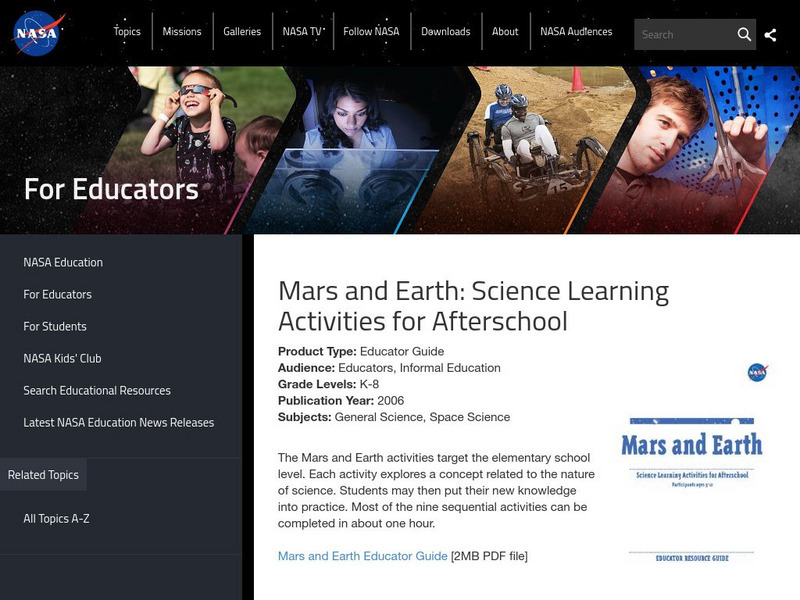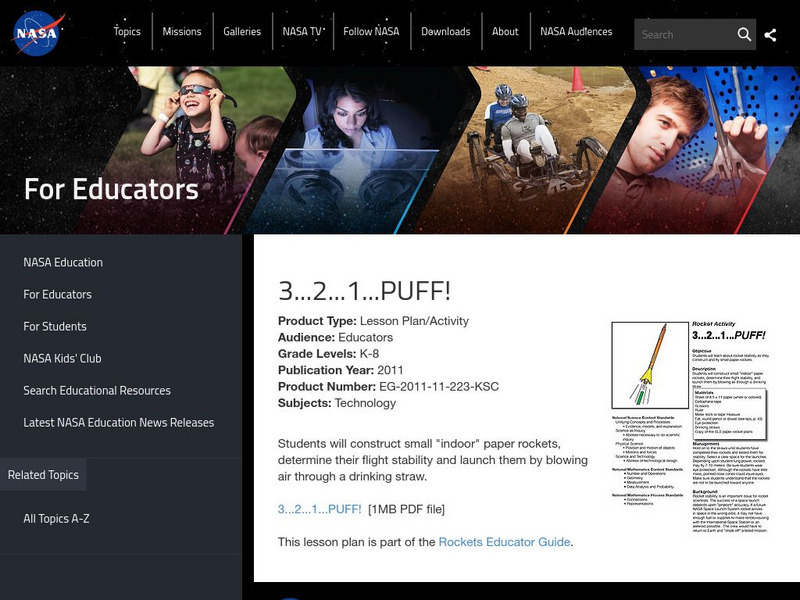Hi, what do you want to do?
NASA
Nasa: Diameter of the Moon: Grades 4 12
This lab activity allows young scholars to calculate the diameter of the moon using proportions. Also follow links to other NASA lesson plans.
NASA
Nasa: Light but Strong
Use these lessons from NASA to teach multiple Next Generation Science Standards for grades K-5. Properties of matter and engineering design are the focus of these lessons. Detailed plans and student handouts are included. [PDF]
NASA
Nasa: Rockets Educator Guide: Heavy Lifting
A lesson plan for students to construct balloon powered rockets. Students will be given the same materials to construct their own rocket and then have a contest to see who can launch the highest paperclip from their rocket.
NASA
Nasa: Aeronautics Educator Guide
This NASA educator's guide provides teachers with an outline for teaching aeronautics activities. Through hands-on activities, students can learn all about flying.
NASA
Nasa: Mars and Earth: Science Learning Activities for Afterschool
This set of activities teaches students about the big picture of science using Mars as an example: how to collect data, use evidence, and look at models.
NASA
Nasa: Optics: Light, Color, and Their Uses
Download this Educators Guide to light, color, and their uses. Choose from different activities using lenses, prisms, hidden messages, periscopes, and kaleidoscopes
NASA
Nasa: Optics: Light, Color, and Their Uses
Download this Educators Guide to light, color, and their uses. Choose from different activities using lenses, prisms, hidden messages, periscopes, and kaleidoscopes
NASA
Nasa: Rockets Educator Guide: Pop Can "Hero Engine"
This lesson plan has students make water propelled engines using pop drink cans. Students will test the effectiveness of the engines and determine anything that affects the action.
NASA
Nasa: Rockets Educator Guide: 3, 2, 1, Puff!
This lesson gives directions for students to construct small, paper rockets that can be launched inside. The students will determine how stable the rocket is and launch them by blowing air through a straw.
NASA
Nasa: Exploration: Then and Now: Settlement Lesson
This lesson has students examine different land to determine whether settlement is affected by an area's location, soil, and weather.
NASA
Nasa: The Brain in Space
This educators guide shows young scholars how the body's brain, spinal cord and network of nerves control the activities of animals and humans.
NASA
Nasa: Cool Suits Activity
"Which color, black or white, reflect energy?" "Which color absorbs energy better?" Through this activity, students will find the answers to these questions, and they will then be able to relate their findings to the construction of...
NASA
Nasa: Mars and Earth: Science Learning Activities for Afterschool
This set of activities teaches students about the big picture of science using Mars as an example: how to collect data, use evidence, and look at models.
PBS
Pbs Teachers:nasa's Return to Flight: Testing Insulating Materials
Examine online articles about the Columbia mission accident and liquid fuel propulsion. Conduct an experiment to determine the best material for insulation.
American Geosciences Institute
American Geosciences Institute: Earth Science Week: Rock Around the World
Classes from around the country collect rock samples and send them in to be analyzed by NASA scientists.
















